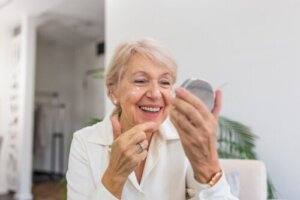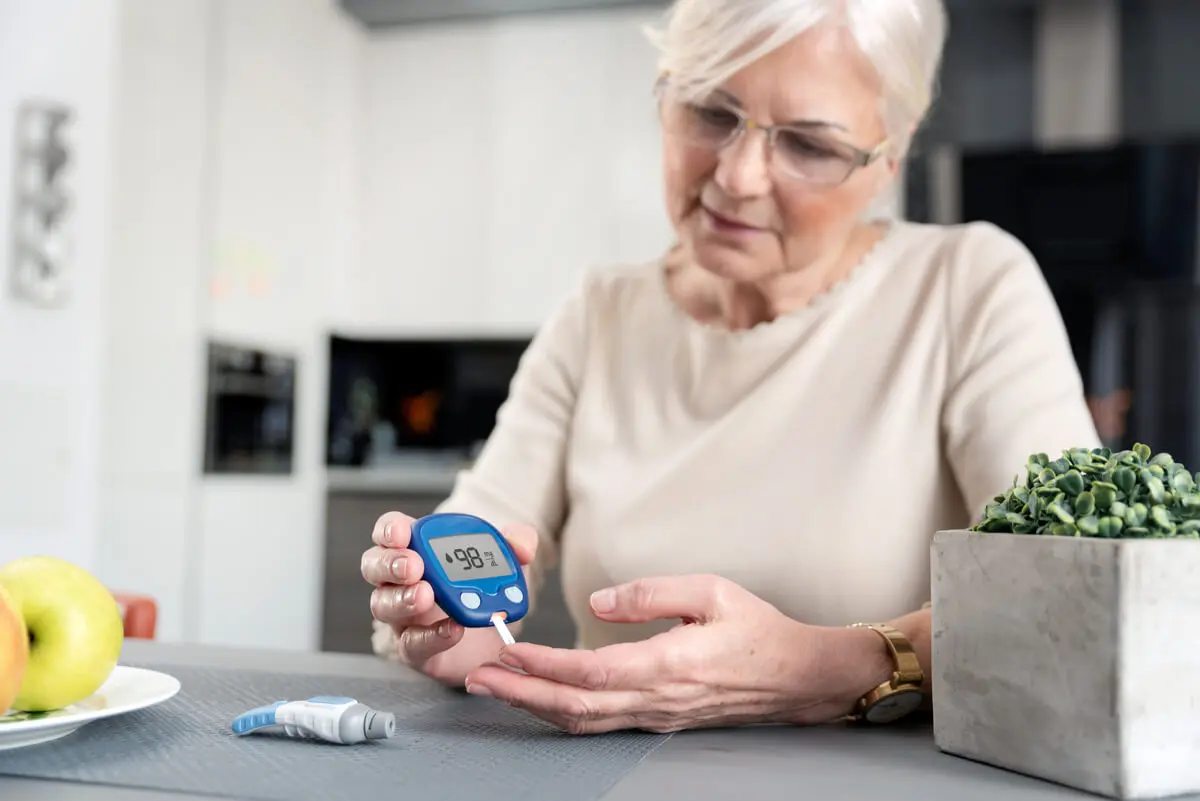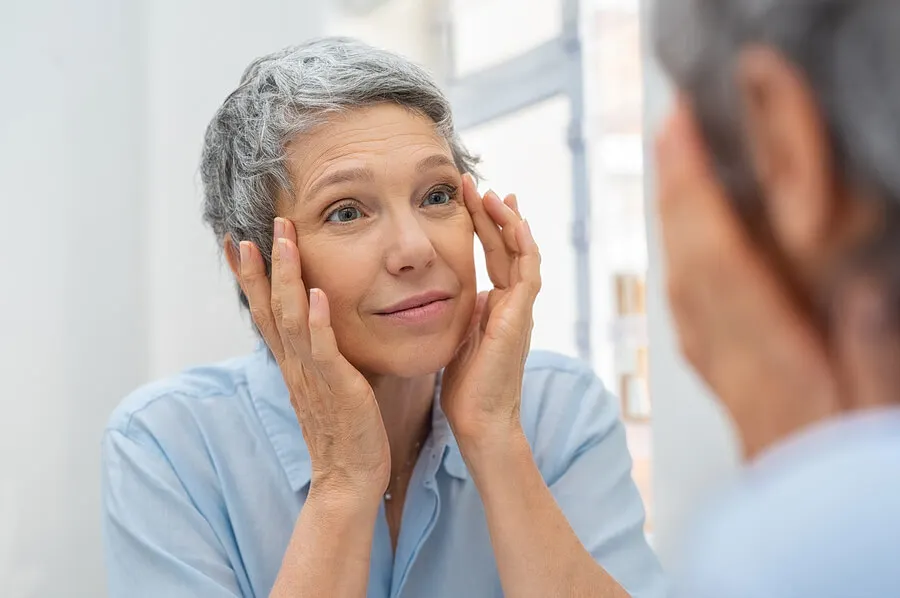How to Care For Dry Skin in Older Adults

Dry skin in older adults brings several problems, such as redness, irritation, roughness, cracking, peeling and more chances of bruising, among others.
And although the skin aging process is common, there are steps that can be taken to reduce these symptoms and reduce the appearance of dryness. In this article, we’ll learn how to care for dry skin in older adults and which factors to avoid – factors that can actually aggravate the problem.
Signs of dry skin in older adults
Age-induced dryness can affect different skin types equally. This, in turn, can be seen more noticeably in some areas, such as the lower legs, elbows and creases.
During this skin aging process, certain changes take place in the different layers of the tissue. For example, the stratum corneum, which is the outermost layer, loses its ability to efficiently store moisture.
The dermis loses elasticity and density due to a decrease in collagen production, both because of aging fibroblasts and a lower level of mechanical stimulation. And, in the deeper layers, adipocytes (fat-storing cells) are reduced in size and quantity.
As a consequence, the following signs can be observed:
- Wrinkles
- Itching
- Thinner skin
- Spots are formed
- A loss of moisture
- Cracking and flaking
- Cuts and wounds taking longer to heal
You may also be interested in: 4 Vitamins for Healthy Skin
Factors that increase skin dryness
Aging and dry skin in older adults, as well as the symptoms referred to above, will be much more intense and noticeable if certain other factors come into the equation. Some of them are preventable, and we’ll tell you about them so that you can take them into account.
Pathologies
According to studies, dry skin is one of the most frequent problems in diabetic patients (50%), followed by hyperkeratosis or thickening of the external layer (33.5%). In addition, a 2015 review mentions that, among the symptoms of renal patients undergoing hemodialysis, dry skin and itching are often found.

Hormonal disorders
Hormonal changes associated with aging can also exert a major impact on the appearance of dry skin in older adults. In the case of women, with the onset of menopause and the decrease in estrogen levels, the production of elastic fibers is affected.
Sun exposure
Excessive exposure to the sun’s rays is associated with the development of various skin diseases. A relationship has even been established between ultraviolet (UV) radiation and skin cancer.
Hydration
A lack of adequate hydration, in the sense of consuming little liquid during the day, can worsen the problem of dry skin, and not only in older adults.
Cosmetic and hygiene products
The excessive use of soaps, deodorants, perfumes, and some creams can contribute to dryness. Also, when the pH of products is higher than 8, it affects the skin’s natural oils.
Genetic predisposition
Factors associated with skin color can make a difference in aging and age-induced dryness. According to some studies, the stratum corneum in black people has more layers of cells than in white people. Therefore, the impact of environmental factors may be less on darker skin.
Other factors
There are other possible reasons why skin dryness may worsen:
- Stress
- Smoking
- Living in places with very dry or cold air
- Frequent hot baths
- Medications such as antihypertensive diuretics, corticosteroids, oral contraceptives, antineoplastics and retrovirals.
Continue reading about the topic and discover The Best Homemade Remedies To Moisturize Dry Skin
How to look after dry skin in older adults
According to research, dry skin care in older adults should be comprehensive and include several strategies, such as the ones we’ll see below.
Moisturizing
On the one hand, fluid intake should be increased by drinking at least 2 liters of water a day. However, this may vary from person to person. Likewise, the presence of fresh fruit and vegetables in the diet should be increased.
On the other hand, the use of topical moisturizing products (creams or gels) is recommended. Preferably, these should be applied after bathing to help retain moisture.
Caution with hygiene products
Caution should be exercised with hygiene products, since dry skin is sensitive and some reactions may occur. Therefore, it’s recommended to avoid alkaline solutions, perfumes, dyes, and certain chemicals, such as triclosan, parabens, formaldehyde, and oxybenzone.
Always check the pH level of the product.
Avoid cold, dry air
Avoid anything that contributes to dry skin. Therefore, if you live or work in an environment where the air is very dry, you should use a humidifier.
Also, in summer, when the environment is very hot, or on the contrary, in winter, when the temperature drops, you should take precautions to avoid changes in the moisture balance.
Reduce sun exposure
It has already been mentioned that excessive exposure to the sun can be harmful and that the skin of older adults tends to be more sensitive. But we must also mention that the effect of ultraviolet radiation is cumulative. The longer we expose ourselves to the sun, the greater the risk of melanoma forming.
Therefore, when going outdoors, some measures should be taken:
- Avoid the hours of highest sunlight intensity
- Use a broad-spectrum sunscreen
- Wear sunglasses and a hat
- Wear clothing that covers and protects
- Walk in the shade
- Don’t use tanning methods, not even with lamps or tanning beds

Avoid hot water
Whether showering or bathing in a tub, or washing your face or hands, too hot water should be avoided, as it can make the skin drier. It’s preferable to use cold water and, if it’s winter, warm water, but without exceeding 40°C.
Taking care of your diet
Diet is also important when it comes to caring for dry skin in older adults, since a diet rich in antioxidants can reduce the effects of oxidative stress.
In this regard, the following are among the foods recommended for dry skin:
- Food with high water content: watermelons, melons, oranges, grapes, tomatoes, cucumbers, onions.
- Those rich in beta-carotene: Spinach, carrots, pumpkin, and bell peppers.
- Food rich in vitamin B: Meat, eggs, and dairy products.
- Those rich in zinc: Oysters, sardines, pumpkin seeds.
- Food with a good sulfur content: Asparagus, garlic and others.
- Sources of omega-3 fatty acids: Fish, shellfish, and nuts.
When to see a doctor?
With age, the skin may suffer from certain changes in texture or general appearance. However, there are some signs to be aware of. For example, itching or redness that persists over time.
Similarly, although they can form easily, it’s important to pay attention to bruises that appear for no apparent reason, especially those that are on parts of the body covered by clothing.
On the other hand, moles, spots or marks should be evaluated taking into account the ABCDE system:
- Asymmetry: Parts of the mark look different from each other.
- Borders: If they are irregular.
- Color: If there are changes.
- Diameter: More than 0.5 cm.
- Evolution: If it grows, or changes shape or appearance over time.
If these or other symptoms appear, and there’s also bleeding, then you should visit your doctor to rule out a possible cancerous formation.
All cited sources were thoroughly reviewed by our team to ensure their quality, reliability, currency, and validity. The bibliography of this article was considered reliable and of academic or scientific accuracy.
- Gutiérrez Sánchez D, Leiva-Santos J, Sánchez-Hernández R, Gómez García R. Prevalence and evaluation of symptoms in advanced chronic kidney disease. Enferm Nefrol. 2015; 18(3): 228-236.
- Hurlow J, Zimmaro D. Dry Skin in Older Adults. Geriatric Nursing, 2011; 32(4): 257-262.
- Ibarra C, Rocha J, Hernández R, et al. Prevalencia de neuropatía periférica en diabéticos tipo 2 en el primer nivel de atención. Rev. méd. Chile. 2012; 140(9): 1126-1131.
- Pons-Guiraud A. Sensitive skin: a complex and multifactorial syndrome. Journal of Cosmetic Dermatology. 2004; 3: 145-148.
- Toro Giraldo A, Gaviria M. Cambios intrínsecos de la piel en el adulto mayor. Revista Asociación Colombiana de Dermatología & Cirugía Dermatológica. 2006; 14(2): 129-138.
- Varani J, Dame M, Rittie L, et al. Decreased Collagen Production in Chronologically Aged Skin: Roles of Age-Dependent Alteration in Fibroblast Function and Defective Mechanical Stimulation. The American Journal of Pathology. 2006; 168(6): 1861-1868.
This text is provided for informational purposes only and does not replace consultation with a professional. If in doubt, consult your specialist.








